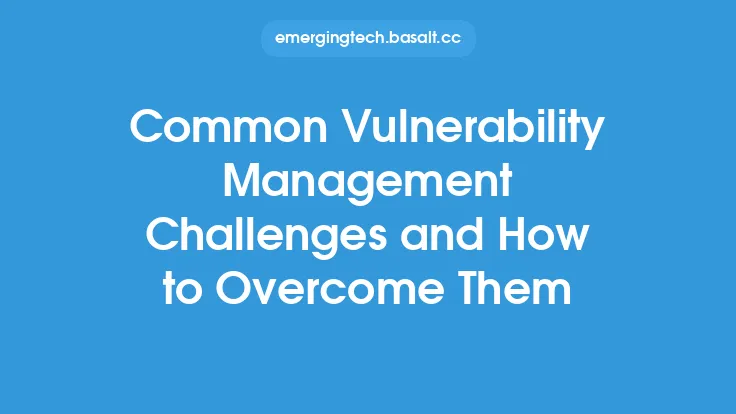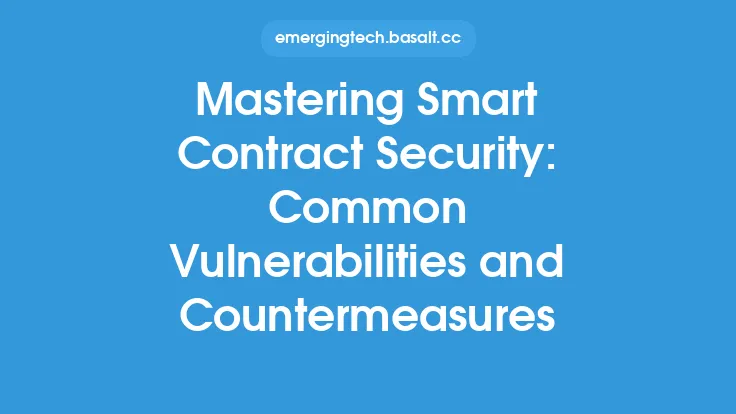The blockchain ecosystem has grown exponentially over the years, with more individuals, businesses, and organizations adopting the technology. However, as with any emerging technology, blockchain is not without its security risks. The decentralized and immutable nature of blockchain makes it an attractive target for hackers and other malicious actors. In this article, we will explore some of the most common blockchain security risks and discuss ways to mitigate them.
Introduction to Blockchain Security Risks
Blockchain security risks can be broadly categorized into two types: internal and external risks. Internal risks refer to vulnerabilities within the blockchain network itself, such as smart contract bugs or consensus algorithm weaknesses. External risks, on the other hand, refer to threats from outside the network, such as hacking, phishing, or other types of cyber attacks. Understanding these risks is crucial to developing effective mitigation strategies.
Smart Contract Risks
Smart contracts are self-executing contracts with the terms of the agreement written directly into lines of code. They are a critical component of many blockchain applications, but they can also be a source of security risks. One of the most significant risks associated with smart contracts is the possibility of bugs or vulnerabilities in the code. If a smart contract contains a bug, it can be exploited by hackers, resulting in financial losses or other types of damage. To mitigate this risk, it is essential to thoroughly test and audit smart contracts before deploying them on a blockchain network.
Consensus Algorithm Risks
The consensus algorithm is the mechanism by which a blockchain network achieves agreement on the state of the blockchain. Different consensus algorithms have different security risks associated with them. For example, proof-of-work (PoW) algorithms are vulnerable to 51% attacks, where a group of miners control more than half of the network's mining power and can manipulate the blockchain. To mitigate this risk, some blockchain networks use alternative consensus algorithms, such as proof-of-stake (PoS) or delegated proof-of-stake (DPoS).
Wallet and Exchange Risks
Blockchain wallets and exchanges are critical infrastructure for the blockchain ecosystem, but they can also be a source of security risks. One of the most significant risks associated with wallets and exchanges is the possibility of hacking or theft. If a wallet or exchange is compromised, users can lose their funds or have their personal data stolen. To mitigate this risk, it is essential to use reputable and secure wallets and exchanges, and to follow best practices for securing accounts, such as using two-factor authentication and keeping software up to date.
Network Risks
Blockchain networks can be vulnerable to various types of network risks, including denial-of-service (DoS) attacks, eclipse attacks, and routing attacks. DoS attacks involve overwhelming a network with traffic in order to make it unavailable to users. Eclipse attacks involve manipulating a network's routing tables in order to intercept or manipulate traffic. Routing attacks involve manipulating a network's routing protocols in order to redirect traffic. To mitigate these risks, it is essential to implement robust network security measures, such as firewalls, intrusion detection systems, and secure routing protocols.
Social Engineering Risks
Social engineering is a type of attack that involves manipulating individuals into divulging sensitive information or performing certain actions. In the context of blockchain, social engineering risks can include phishing attacks, where attackers send fake emails or messages that appear to be from a legitimate source, or pretexting attacks, where attackers create a fake scenario in order to trick individuals into divulging sensitive information. To mitigate these risks, it is essential to educate users about the dangers of social engineering and to implement robust security measures, such as multi-factor authentication and secure communication protocols.
Mitigating Blockchain Security Risks
Mitigating blockchain security risks requires a multi-faceted approach that involves both technical and non-technical measures. Some of the most effective ways to mitigate blockchain security risks include:
- Implementing robust security protocols, such as encryption and secure authentication
- Conducting regular security audits and penetration testing
- Educating users about the dangers of social engineering and other types of attacks
- Implementing incident response plans in case of a security breach
- Staying up to date with the latest security patches and updates
- Using reputable and secure wallets and exchanges
- Following best practices for securing accounts, such as using two-factor authentication and keeping software up to date.
Conclusion
Blockchain security risks are a significant concern for individuals, businesses, and organizations that use blockchain technology. However, by understanding the types of risks that exist and implementing effective mitigation strategies, it is possible to minimize the likelihood of a security breach. By prioritizing security and taking a proactive approach to mitigating risks, we can help to ensure the long-term viability and success of the blockchain ecosystem.





